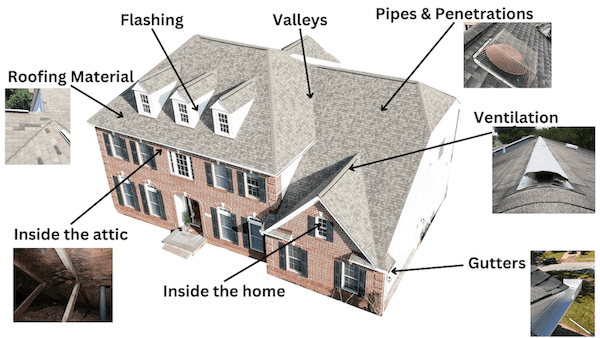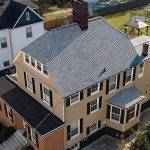Parts of a Roof
Understanding the different parts of a roof is essential for homeowners, contractors, and anyone involved in construction or renovation projects. A roof is a complex system made up of numerous components that work together to protect a building from the elements. Every element must be carefully selected and maintained to prevent leaks, improve insulation, and enhance the roof’s aesthetic appeal. Below, we break down the key parts of a roof system and discuss the different components of your roof.
The Parts of a Roof System (Diagram)
This diagram of the parts of a roof provides a visual representation of the various components that make up a roofing system. We created this graphic to illustrate how the different parts interconnect to ensure structural integrity and weather resistance. This detailed diagram highlights key elements such as underlayment, decking, rafters, and flashing. By examining this diagram, you can gain valuable insights into the complex construction of roofs, enabling you to make more informed decisions about maintenance and repairs.

Learn more with this video from Owens Corning:
The Main Roof Parts Names
The main parts of a roof include several essential components that work together to provide structural integrity, protection from the elements, and proper ventilation. Here are the primary parts of a roof:
Shingles or Roofing Tiles
Shingles or tiles are the outermost layer of the roof that provides the first line of defense against the elements. They come in various materials, such as asphalt, wood, metal, slate, and clay, each offering different levels of durability, aesthetic appeal, and weather resistance.
Underlayment
The underlayment is a protective layer installed between the roof deck and the shingles. It acts as an additional barrier against water infiltration, offering protection in case the outer roofing materials are damaged or compromised.
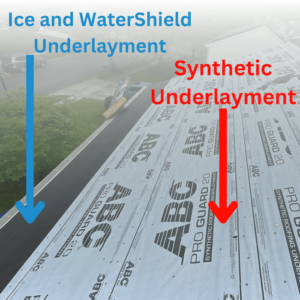
Flashing
Flashing is made from thin pieces of metal or other impermeable materials installed around roof penetrations (such as chimneys, vents, and skylights) and along roof edges to prevent water from seeping into the roof structure. Proper flashing installation is crucial to prevent leaks.
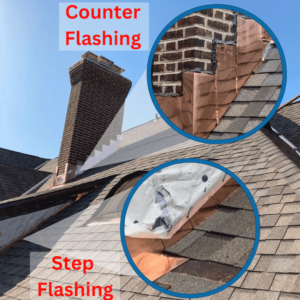
Fascia
The fascia is the horizontal board that runs along the edge of the roof, covering the ends of the rafters. It provides a finished look to the roof and supports the gutters, protecting the roof edge from water damage.
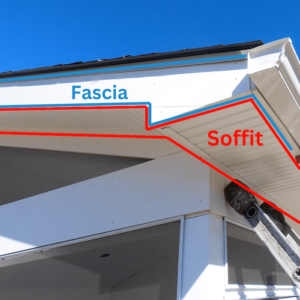
Soffit
The soffit is the underside of the eaves, connecting the roof overhang to the exterior wall of the house. It helps ventilate the attic and protects the rafters from weather exposure.
Skylights
Skylights are windows installed in the roof to allow natural light into the interior spaces. They are often equipped with flashing to prevent leaks and can include additional features such as UV protection and ventilation.
Solar Panels
Solar panels can be mounted on different types of roofing materials and structures, making them a versatile addition to residential homes. Solar panels are an eco-friendly and cost-effective way to reduce energy bills.
Understanding these additional roof parts and their functions helps homeowners and contractors ensure a comprehensive and effective roofing system. Proper selection, installation, and maintenance of these components are vital for the roof’s performance, longevity, and aesthetic appeal.
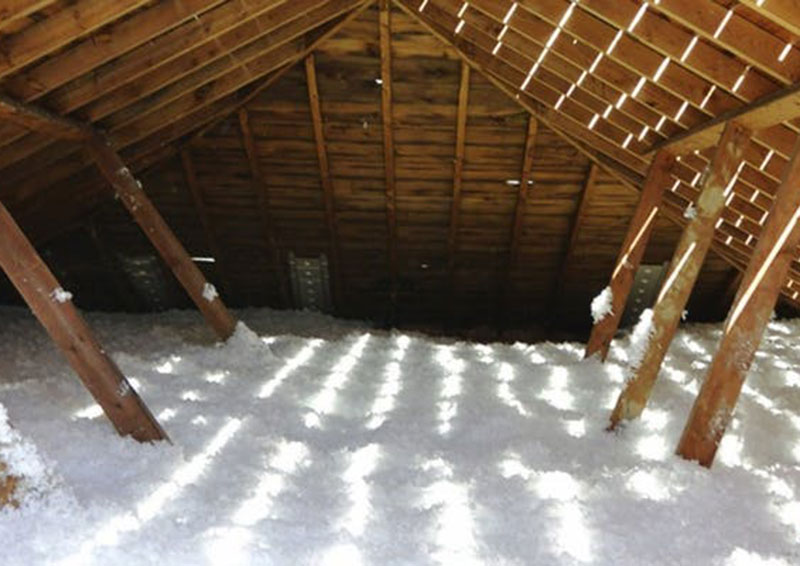
Structural Components of a Roof
The structural components of a roof form the backbone of its overall integrity, ensuring that it can withstand various loads and environmental stresses. These components include the following key elements:
- Roof Decking (Sheathing): The roof decking, usually made from plywood or oriented strand board (OSB), provides a solid surface for the application of roofing materials. It is attached to the rafters or trusses and serves as the base layer that supports the underlayment and shingles.
- Rafters: Rafters are the sloping beams that extend from the ridge or hip of the roof down to the eaves, supporting the roof deck and any additional loads such as snow or heavy winds. They form the main framework of the roof and determine its shape and slope.
- Trusses: Trusses are prefabricated triangular units that provide additional support and stability to the roof. They are often used in modern construction for their efficiency in distributing weight and ease of installation. Trusses can support more weight than traditional rafters and are commonly used in larger roofing structures.
- Eaves: The eaves are the edges of the roof that extend beyond the exterior walls of the house. They provide an overhang that helps to direct rainwater away from the walls and foundation, reducing the risk of water damage. Eaves often include components such as the soffit and fascia.
- Collar Ties: Collar ties are horizontal beams installed between opposing rafters in the upper third of the roof structure. They help resist the rafters’ outward thrust and add rigidity to the roof frame.
- Ridge Board: The ridge board is the horizontal beam at the peak of the roof where the rafters meet. It provides a nailing surface for the rafters and helps to align them properly.
These structural components work together to create a strong, stable, and durable roof capable of withstanding various environmental stresses while providing a secure covering for the building beneath.
Drainage Components of a Roof
The drainage components of a roof are critical for directing water away from the structure, preventing water damage, and maintaining the integrity of the roofing system. These components of your roof’s drainage system include the following key elements:
- Gutters: Gutters are horizontal channels installed along the edges of the roof that collect rainwater and direct it to downspouts. They prevent water from cascading off the roof and eroding the foundation or landscaping below.
- Downspouts: Downspouts are vertical pipes connected to the gutters, channeling collected water from the roof to the ground or a designated drainage area. They are essential for guiding water away from the building’s foundation to prevent water damage and flooding.
- Gutter Guards: Gutter guards are protective covers or screens placed over gutters to prevent debris such as leaves, twigs, and dirt from clogging the drainage system. They help maintain the efficiency of the gutters and reduce the need for frequent cleaning.
- Ice and Water Shield: This self-adhering membrane is installed in vulnerable areas such as roof valleys, eaves, and around penetrations to provide extra protection against ice dams and wind-driven rain.
- Drip Edge: The drip edge is a metal flashing installed along the edges of the roof to direct water away from the fascia and into the gutters, preventing water damage to the roof structure.
- Valleys: Valleys are the internal angles formed by the intersection of two sloping roof planes. They channel water down the roof and into the gutters. Proper installation and maintenance of valley flashing are crucial to prevent leaks in these areas.
- Ridge Caps: These are specialized shingles designed to cover the hips and ridges of the roof, providing a finished appearance and additional protection against water infiltration at these critical junctions.
- Chimney Cap: A chimney cap is a protective covering placed over the top of a chimney to prevent rain, debris, and animals from entering. It also helps to prevent downdrafts and improves the chimney’s efficiency.
These drainage components work together to efficiently manage rainwater and melting snow, protecting the roof and the building from water damage. Proper design, installation, and maintenance of these elements are essential for the longevity and performance of the roofing system.

Ventilation Systems of a Roof
Proper roof ventilation is essential for maintaining the longevity and efficiency of a roofing system. It helps regulate temperature, reduce moisture buildup, and prevent issues such as mold growth and ice dams. The key components of a roof ventilation system include the following:
- Insulation Materials: Roof insulation is typically installed within the attic space or between the roof rafters to improve the energy efficiency of the building. Insulation materials help to maintain a consistent indoor temperature by reducing heat loss in the winter and heat gain in the summer. Common insulation materials include fiberglass batts, spray foam, cellulose, and rigid foam boards.
- Ridge Vents: Ridge vents are installed along the peak of the roof, allowing warm, moist air to escape from the attic. They provide continuous ventilation across the entire roof and are often covered with ridge cap shingles to blend in with the roofline.
- Soffit Vents: Soffit vents are located under the eaves of the roof and allow fresh air to enter the attic. They work in conjunction with ridge vents to create a natural airflow, with cooler air entering through the soffit vents and warmer air exiting through the ridge vents.
- Gable Vents: Gable vents are installed in the gable ends of the attic, typically near the peak of the roof. They facilitate cross-ventilation by allowing air to flow in and out of the attic through the gable ends. Gable vents can be used in conjunction with other ventilation systems or as standalone solutions in certain roof designs.
- Attic Fans: Attic fans, either powered by electricity or solar energy, help to actively ventilate the attic by drawing in cooler air from the soffit vents and expelling hot air through the roof vents. They are particularly useful in climates with extreme temperatures.
- Box Vents: Box vents, also known as low-profile vents or turtle vents, are installed near the roof ridge and rely on natural convection to release hot air from the attic. They are typically used in conjunction with soffit vents to ensure proper air circulation.
- Vent Pipes: Vent pipes, also known as plumbing vents, protrude through the roof and allow sewer gases to escape from the plumbing system to the outside. They also help to regulate air pressure in the plumbing pipes, ensuring that water flows smoothly through the drains. Vent pipes are often sealed with flashing to prevent leaks around the penetration point in the roof.
A well-designed ventilation system is crucial for maintaining the structural integrity of the roof, improving energy efficiency, and ensuring a comfortable living environment. Proper installation and maintenance of these components are essential to prevent issues such as moisture buildup, mold growth, and excessive heat accumulation in the attic.

Roofing Systems For Different Roofing Materials
Different roofing systems are designed based on the type of roofing material used. Each material has unique properties that influence the overall structure, installation process, and maintenance requirements of the roofing system. Here are some common roofing systems categorized by their materials:
Asphalt Shingle Roof Parts
An asphalt shingle roof is a popular and versatile roofing system consisting of several key components that work together to provide durability, weather resistance, and aesthetic appeal. Asphalt shingles are affordable, easy to install, and come in various styles and colors. They provide good protection against weather and are suitable for most climates. Here are some of the main components of an asphalt shingle roof:

Asphalt Shingles
- Description: The outermost layer of the roof, made from a base mat (usually fiberglass) coated with asphalt and topped with mineral granules for UV protection and color.
- Function: Provides the primary protection against weather elements, including rain, wind, and sunlight.
Underlayment
- Description: A protective layer installed directly on the roof decking beneath the shingles. It is typically made from felt (tar paper) or synthetic materials.
- Function: Acts as an additional barrier against water infiltration, protecting the roof deck if shingles are damaged or lifted.
Starter Strip Shingles
- Description: Special shingles installed along the eaves and sometimes rakes of the roof before the first course of regular shingles.
- Function: Provides an adhesive barrier to secure the edges of the first row of shingles, preventing wind uplift and water infiltration.
Fasteners (Nails)
- Description: Roofing nails used to secure shingles and other roofing components to the roof deck.
- Function: Provides the primary means of attachment for shingles, ensuring they remain in place during adverse weather conditions.
Parts of a Metal Roof
A residential metal roof is a durable and long-lasting roofing system that provides excellent protection against the elements. They are also energy-efficient and recyclable. Here are some of the main components of a metal roof:
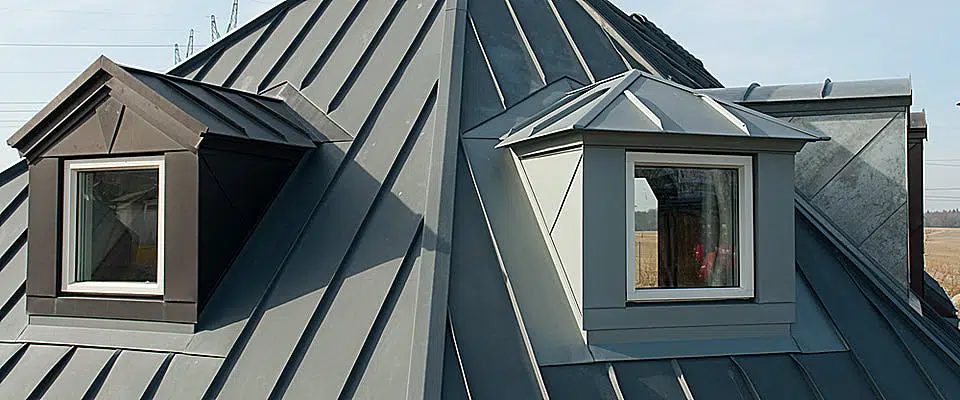
Metal Panels or Shingles
- Description: The primary roofing material, available in various metals such as steel, aluminum, copper, or zinc, and in styles including standing seam, corrugated, or metal shingles.
- Function: Provides the main barrier against weather elements, including rain, wind, snow, and sunlight.
Underlayment
- Description: A protective layer installed directly on the roof decking beneath the metal panels or shingles. Common materials include synthetic underlayment or felt.
- Function: Acts as an additional moisture barrier, protecting the roof deck from water infiltration.
Fasteners (Screws)
- Description: Special screws with rubber or neoprene washers used to secure metal panels and other roofing components to the roof deck.
- Function: Ensures the metal panels remain in place during adverse weather conditions and prevents water infiltration at the attachment points.
Metal Trim
- Description: Custom-fabricated pieces used to finish edges, corners, and transitions on the roof, such as rake trim, eave trim, and valley trim.
- Function: Provides a neat, finished appearance and additional protection against water infiltration at critical junctions.
Parts of a Tile Roof
A tile roof is a durable and attractive roofing system that is often used for its aesthetic appeal and longevity. Tile roofs are highly durable, fire-resistant, and have a long lifespan. They are available in various styles and colors, enhancing the aesthetic appeal of a home. Here are the main components of a tile roof:
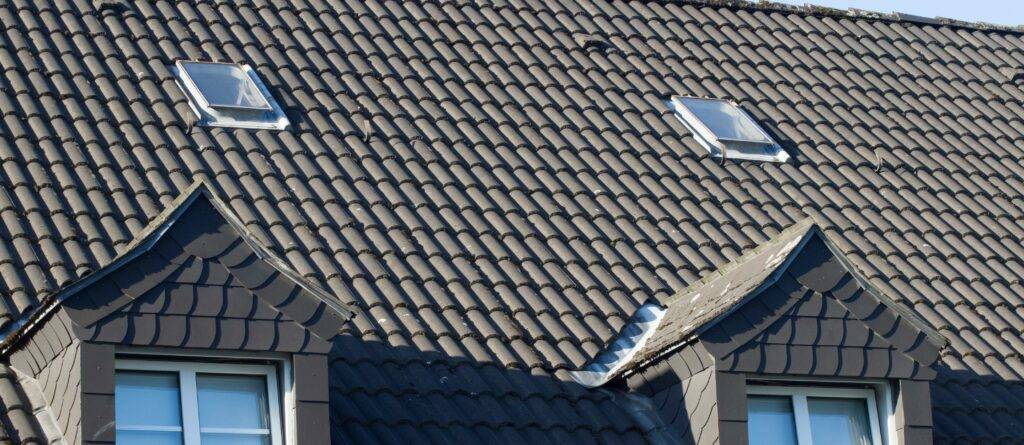
Roof Tiles
- Description: The primary roofing material, typically made from clay or concrete, available in various styles such as flat, curved, or interlocking.
- Function: Provides the main barrier against weather elements, including rain, wind, and sunlight, and contributes to the roof’s aesthetic appeal.
Underlayment
- Description: A protective layer installed directly on the roof decking beneath the tiles. Common materials include felt or synthetic underlayment.
- Function: Acts as an additional moisture barrier, protecting the roof deck from water infiltration.
Fasteners (Clips or Nails)
- Description: Clips or nails used to secure the tiles to the battens or roof deck.
- Function: Ensures the tiles remain in place during adverse weather conditions and prevents water infiltration at the attachment points.
Ridge Cap Tiles
- Description: Specially designed tiles that cover the ridge and hip lines of the roof.
- Function: Provides a finished look to the roof while protecting the ridge and hip areas from water infiltration.
Other Parts of A Roofing System
In addition to the components of a roofing system listed above, there are other things that you may see on your home’s roof. These things aren’t necessarily structural parts of the roof, but instead are related systems that can be found on the roof, such as HVAC system vents and other home venting systems.
If you want to learn more about your home’s roofing system and get a free roof inspection by our team, contact us today!
Article Updated: June 10, 2024

